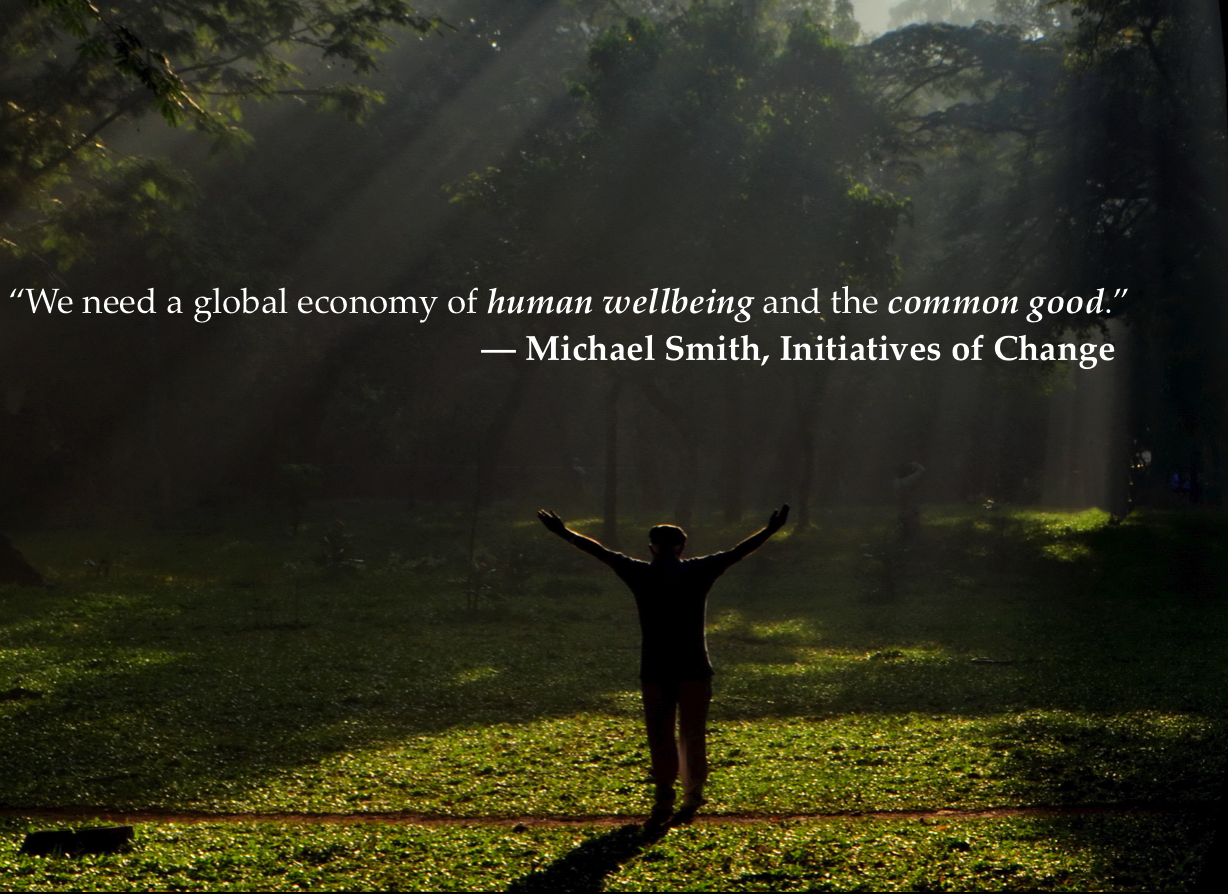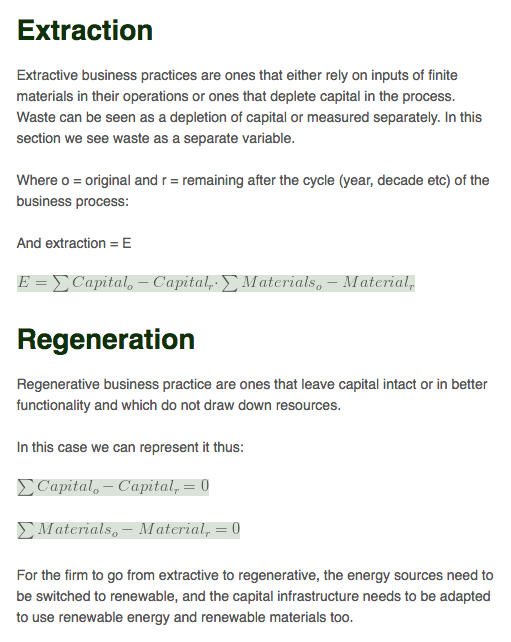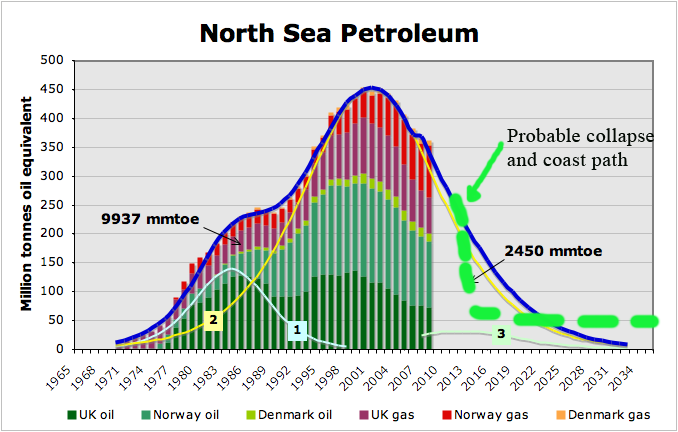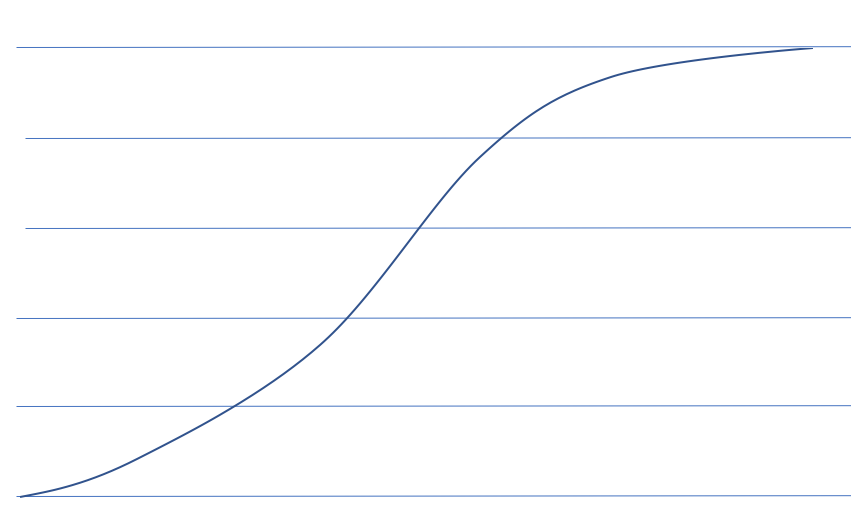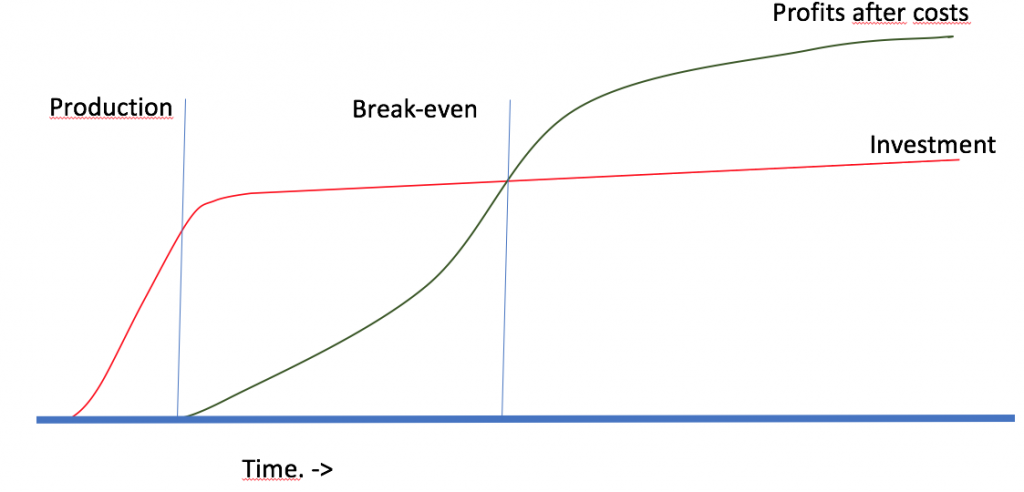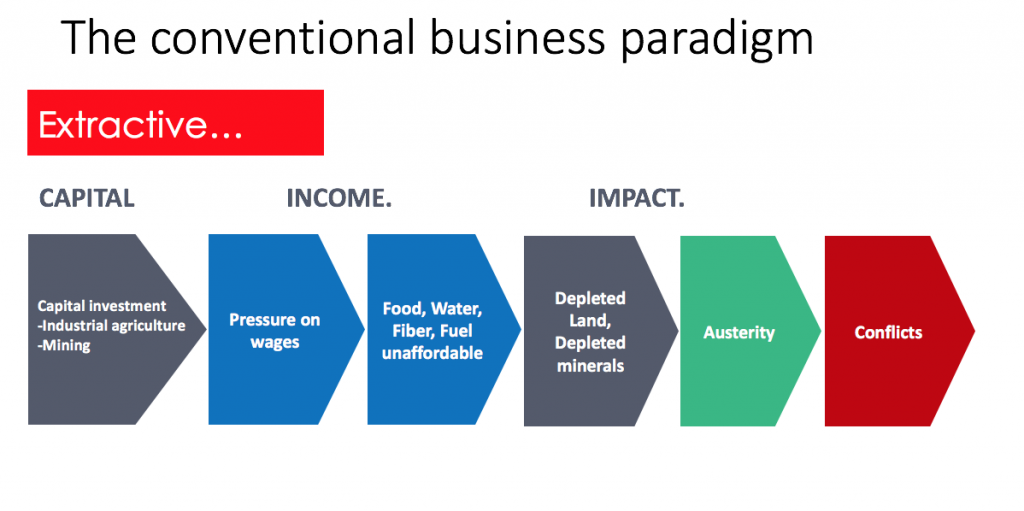Extractive economy is business-as-usual and the mental model taught in business schools. It is not called that of course, but examining any business textbook will reveal that the mental model – or paradigm – of extraction is underlying most teaching. This article aims to explain in clear terms what extractive models are, point out some of the shortcomings and hopefully opens up to the possibility of other, more functional, models.
Summary:
Seldom do business textbooks describe the paradigm of modern business as extractive – that is to say based on extracting resources from the earth without replenishing or recycling them. This is possibly because the practice is so ingrained in our way of life that it is taken as the only way. Extractive business practices deplete resources and downgrade capital. It is rather surprising that the dominant business paradigm is capitalism and yet it runs on degrading capital. On a finite planet, this is surely not good business let alone good for the planet. A dialogue around extractive approaches can be helped by naming what is going on and describing the paradigm. Several patterns associated with extractive approaches are described including the bell-curve of oil field extraction and the accumulated capital investment curves precluding break-even. Extractive approaches have many social downsides including externalization of negative effects like pollution and noise, but the main challenge is that they are actually not even good business, especially as investments for fiduciary investors.
The basic idea of extractive business
The basic idea of extractive business is that there is a resource to exploit to produce goods and services which are sold at a profit.
By exploiting the resource:
- it gets used up (resources) or degraded (capital asset)
- money gets made by the people putting up money in the beginning
- money is made by the extractor
- it creates livelihoods for employees along the whole supply chain
- the extractor typically moves on, using knowledge and technology gained to the next pool of resource
Both resources and capital can be extracted
We should explore the distinctions between resources and capital – both essential components of business approaches. Extractive approaches use up resources, but even risk depleting capital. One of the definitions of capital is that which is used in production of services for payment but not used up. Obviously natural capital is one of the things that firms can use, but capital also includes built capital; buildings, machines, human capital, workers and so on, and social capital; organisations.
Capital can be drawn down, or reduced. For example, natural capital can be eroded if it is treated in such a way that more is extracted than can be regenerated. In this way capital can be treated by firms as a resource. Another example might be railroads. A firm can own railroads and rent them to railroad companies. The firm can maximize profits by reducing investment in maintenance. After a while, the capital asset – the railroad system – is worth less as the functionality of the system is degraded.
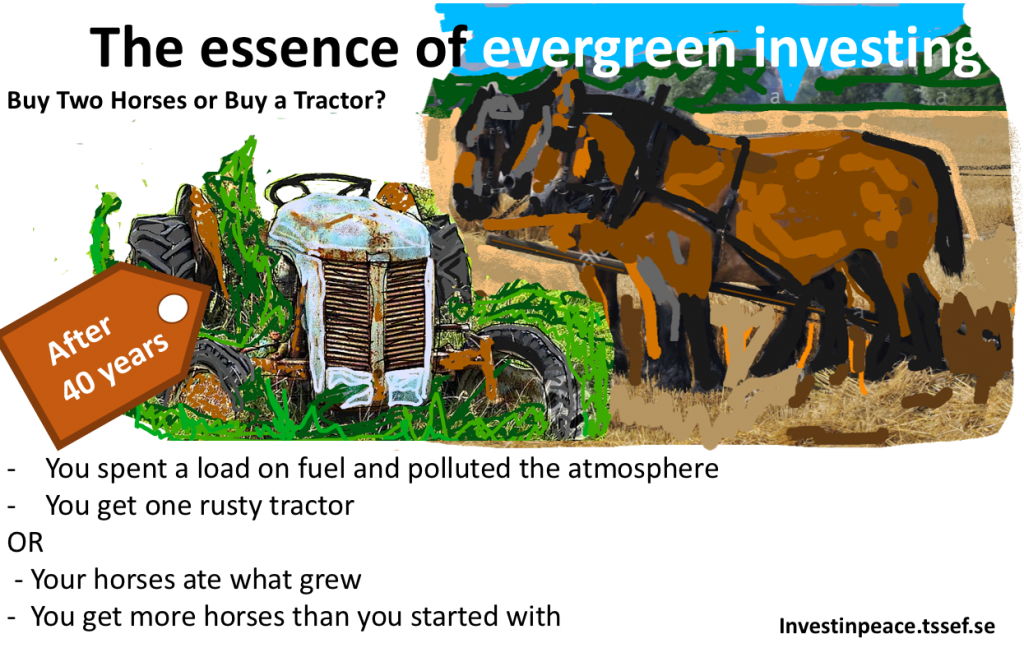 In this other example above, tractors may be effective, but they do not reproduce themselves (or self-repair). In terms of investment, are tractors really a better long-term?
In this other example above, tractors may be effective, but they do not reproduce themselves (or self-repair). In terms of investment, are tractors really a better long-term?
Resources use
Typical examples of resources firms use up to earn money include:
- coal deposits
- oil deposits
Indeed, extractive business like energy companies and food distributers are among the largest corporations on Earth, so it is understandable that the extractive mindset is still dominant in the way business is taught.
TABLE: Largest corporations globally by revenues and their extractive approach Source: Wikipedia
Typical examples of resources being used up include:
- Soil farmed and not regenerated
- Forests clear felled and their ability to regenerate compromised.
- Workers losing their working ability through accidents or industrial illnesses.

This diagram illustrates the results of extractive approaches to food production on soil fertility. SOURCE: United Nations
Patterns of extractive business approaches
Extraction of resources typically follows a bell-shaped curve, illustrated below.
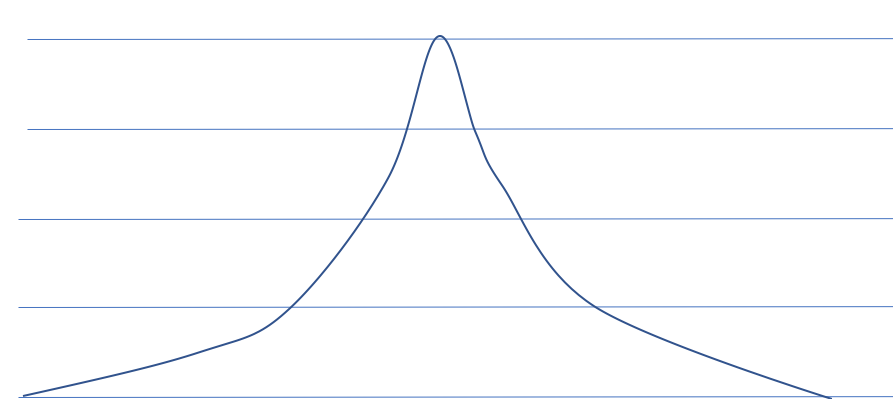
The amount of resource extracted (vertical axis) over time (horizontal axis) typically follows this pattern.
Initially, infrastructure needs to be set up to start extracting the resource, and as this is added production ramps up to about half of the resources are extracted. Typically, the other half of the resource is harder to get at, and production tails off from its peak.
This pattern is seen in oil field exploitation as shown below.
Another way to see this pattern is the “S” curve of accumulated extraction. This pattern is the corollary of the bell curve. Starting fairly slowly, the total amount of extracted resources accelerates and then tapers off towards the end.
The next pattern to consider is how business can be set up around this resource.
Typically, an investment needs to be made before anything can be extracted. This investment – money put up before any earnings can come in – typically comes from the owners of the business who are shareholders/stockholders or from outside investors who offer loans.
This investment follows the pattern below which shows money accumulated as investment.
As you see, the need for money invested rises rapidly in the beginning until a desired rate of extraction is reached. The slight rise after that represents the investment in replacing worn-out equipment.
The diagram below illustrates some key points in the business cycle.
- Time to production – from the first dollar invested to when production starts
- Time to break even – where the money earned from the operation is equal to the total amount invested.
- The final result – in this case the accrued profit is about 30% higher than the investment over the total lifetime of the business.
- The costs – these are not shown on the pattern. Costs include maintenance, inputs like fuel and labour.
- Throughout the lifetime of the business it generates jobs and livelihoods for both direct employees and employees in suppliers. It also generates livelihoods for customers using the products.
So what are the downsides with extractive business approaches?
Frontier mentality is unsustainable – cannot go on forever
The amount of extractable resources is finite, so with each completed extraction there is less to find. The model only works when there is a relatively large amount of potential resources to be had. The model drives itself as the investment in one extraction in terms of knowledge and technology can be transferred to the next, so there is a incentive to continue to the next resource. This mentality is something that may have developed in conjunction with the discovery of the North American Continent, as the frontier to the Wild West pushed forwards, successful businesses sought to repeat themselves further across the frontier.
It externalizes a lot of its true costs
Some of the costs of this type of business are actually moved across to society as a whole to to bear, and are not born by the producer or customer. For the oil and coal business these include:
- injured and disabled workers
- the consequences of climate change
- dealing with workers laid off after the industry declines
- changing infrastructure to use alternative sources of product (includes closing down townships near the facility, investment in new railways, etc)
It creates dependency on the extracted resource
The availability of an extracted, finite resource creates dependencies that require whole system changes after the resource depletes. One example we are dealing with today is the need for investment in renewable energy as oil and gas reserves are drawn down.
One way dependency is dealt with is through globalisation. When oil reserves deplete in one country the corporations move to another. So dependency drives globalisation and the risks of exploitation that follow it.
Unavailable for future generations
The whole problem with extracting finite resources in ways that do not let them be re-used is selfish in a way. Firstly, they are made unavailable for future generations, and they are used just by those who happen to find them. There is no thought of just distribution in the extractive approach.
Together with the need to make money to pay investors back, the model pressures wages into a negative spiral towards austerity
It follows from the discourse above that one way to get more money out of an investment is to reduce costs. Labour costs are one obvious target. Once an investment in infrastructure is made, with owners and borrowed money, the race is on to not only cover costs but to find a way to repay the investment with a profit. So there will always be a downward pressure on wages. That in turn creates an affordability problem for the workers’ essentials like fibre, fuel and food. If workers have less money, they have less to spend on goods produced. In order to sell goods produced from extractive practices at prices affordable to workers, there is more pressure to extract, even more cheaply, from land and from the earth. This creates a downward spiral leading to austerity, and ultimately conflicts.
The extractive economy and its relationship to property rights
Extractive business approaches tend to, where property is involved, draw down the ecological functionality of the property if it is land, and if it is machinery, emit pollution and exert other externalized pressures onto society around it.
Examples include:
- Mining – which affects the water quality of the surrounding area
- Industrial agriculture which imposes a nutrient burden on the eco-system around it.
- Vehicle ownership – which emits noise to surroundings
Extractive practices are actually supported in many cases by lax laws that do not protect the rights of surrounding eco-systems or society. For an extractive approach to be acceptable in the modern society, strict environmental, waste and pollution laws should apply.
A doubtful target for fiduciary investing
Through any project’s business cycle, institutional investors, like pension funds, will be looking to place their money to get dividends so they can pay their members’ pensions. These investors are expected to invest with prudence – to provide pensions whilst not degrading living standards for their pension-takers. Extractive businesses, whilst offering shorter-term possibilities of returns, always – by definition – reach an end-point. These businesses are only able to offer the kind of constant returns pension fund seek by having an ongoing portfolio of young, mature and ending extractive projects. As we saw earlier, this means that ordinary workers are being required to invest in extractive business approaches with externalized costs being placed onto society and bearing the risk that the available resources get depleted.
We cannot run all businesses with an extractive approach
We have to find ways to prosper in our present reality where we understand there is no Planet B. In that reality, an extractive economy is quickly seen as truly unsustainable when you start to analyze it. We can’t keep taking more from a place where there is only so much. There ARE alternative non-extractive but harvestable resources. Examples include well-managed soils that continue to be fertile for generations, well-managed forests that can provide fibre and fuel indefinitely, and the sun and wind and tides that can provide energy. There are, too, ways of recycling extracted minerals like copper indefinitely.
If extractive is the dominant business paradigm, the alternative is regenerative. This approach harvests resources whilst ensuring that the underlying capital – soil, forest, energy installation, minerals, etc remain functional and preferably function even better. This is the subject of future explainers.
READ MORE
For a more mathematical treatment of the subject, read this article.
